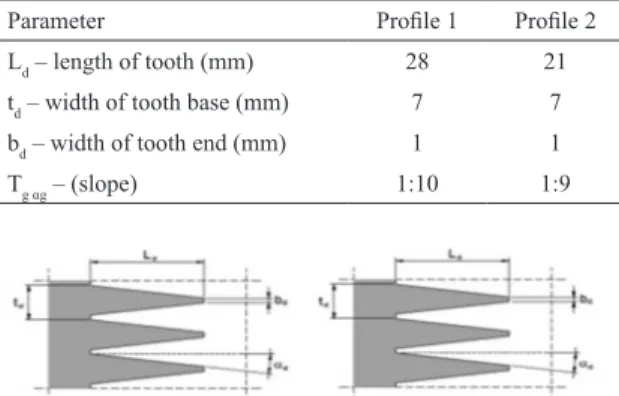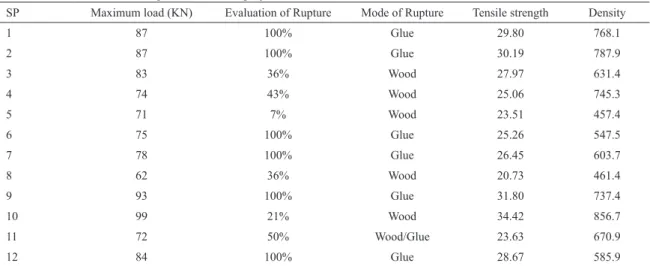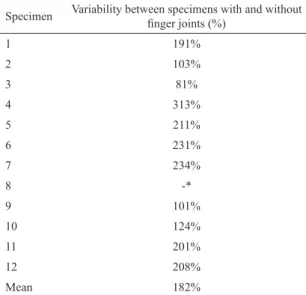Evaluation of Tensile Strength of a
Eucalyptus grandis
and
Eucalyptus urophyla
Hybrid in
Wood Beams Bonded Together by Means of Finger Joints and Polyurethane-Based Glue
Marcos Cesar de Moraes Pereiraa*, Carlito Calil Netoa, Felipe Hideyoshi Icimotoa, Carlito Calil Juniora
Received: January 27, 2016; Revised: August 04, 2016; Accepted: August 20, 2016
Created in the 1940s, the splice inger-joint type for wood has now been more used to compose structural materials wood base as Glued Laminated Timber (Glulam) and Cross Laminated Timber (CLT). The main advantage of this amendment is to provide a simple and economical way to join timber parts on segments. This study evaluated by means of tensile tests the capacity of this type of joint (structural dimension of 21mm) to bond together Lyptus® wood beams (a Eucalyptus grandis and
Eucalyptus urophyla hybrid) using Jowat polyurethane glue (Model 680.20) as compared to similar seamless beams. The results indicate that the seamless beams are 47.72% more resistant to traction (in characteristic values) than those with inger joints. However, to form structural elements where there is redundancy overlapping parts, such as Glulam and CLT, the values obtained can be considered satisfactory. Also noted is that denser samples have better traction results due to better bonding of the densest parts. The use of inger-joint and polyurethane adhesive o bond hybrid eucalyptus, although more brittle than wood without seams, enable the use of shorter wood sections for the composition of major structural elements, optimizing better forest material.
Keywords: Tensile test, Finger joints, Lyptus®, Eucalyptus grandis, Eucalyptus urophyla
* e-mail: marcoscesar@sc.usp.br
1. Introduction
The invention of inger joints for wooden structures, known as inger joints, is commonly attributed to Karl Egner and Jagfeld from Otto Graf Stuttgart Technischer Hoschuele prior to the Second World War. This technique was employed by German forces to repair structural damages resulting from bombing from 1939 to 1945 1. A 1947 study conducted by these authors included reviews of inger joints in wooden bridges built in 1937. However, despite this being the irst known reference to structural use of inger joints, German and American automotive industry had already employed some kind of toothed joint in the manufacture of wooden steering wheels and wooden parts of car wheels in the 1920s2.
Finger joints and glue can be used to bond together two pieces of wood lengthwise on the same plane without resorting to hardware or wooden dowels so as to obtain longer pieces of wood, thereby increasing the use of shorter pieces. It also allows the removal of large nodes from wood pieces and putting them back together afterwards. The advantage of inger joints over other types of joints such as beveled or top joints (Figure 1) is that top joints yield very low mechanical strength, i.e., they do not transmit eforts to the adjacent piece efectively whereas beveled joints, though yielding good strength, demand a lot of wood to be manufactured, since bevels must have a 1:10 slope 3. Thus
inger joints provide an economical approach for joining pieces segments longitudinally4.
The use of wood pieces bonded together lengthwise is particularly suitable for manufacturing glued laminated timber (Glulam) beams and CLT (Cross Laminated Timber) boards, in which wood lamellas are glued together to obtain a wooden beam, arc or boards with special dimensions. Section 5.7.4 of the draft revision (2011) of Brazilian Standards for Wooden Structures — NBR 71905 addresses the use of Glulam and
indicates the required dimensions for inger joints. In order to be considered structural, inger joints have to have the following dimensions:
The geometric parameters cited in Table 1 are presented in Figure 2.
For inger joints to yield the necessary strength to withstand tensile loads, it is necessary to use glues whose structural features and properties are compatible with the environmental conditions to which the wooden structure will be subjected during its service life. There are several structural wood glues, the most common ones being those based on phenol resorcinol, melamine formaldehyde, and polyurethane. Gluing parameters, e.g., quantity, pressure, and pressing time, vary according to manufacturers. In the absence of manufacturer parameters, NBR 7190 recommends the pressure for inger joints to be at least 0.7MPa for wood with density below 0.5g/cm3 and 1.2MPa for wood with density above 0.5g/cm3.
Similarly, in the absence of manufacturer recommendations, a Departamento de Engenharia de Materiais e Laboratório de Madeiras e de Estruturas de Madeira
joints, as recommended in item 13.2 do EN 408:2010 - Timber structures: Structural timber and glued laminated timber - Determination of some physical and mechanical properties8.
According to Appendix B (Determination of properties of wood for design of structures) of NBR 7190 — Brazilian Standards for Wooden Structures 5, which deines testing
methods for structural wooden elements, the tensile strength parallel to the ibers (fwt,0 or ft0) is given by the maximum tensile stress that can act on an elongated sample whose central portion has a uniform cross section area A, length equal to or above 8√A, ends stronger than central portion, and concordances that ensure rupture at the central portion, as follows:
Figure 1: Types of joints1.
Table 1: Geometric speciications for teeth recommended by NBR 7190.
Parameter Proile 1 Proile 2
Ld – length of tooth (mm) 28 21
td – width of tooth base (mm) 7 7
bd – width of tooth end (mm) 1 1
Tg αg – (slope) 1:10 1:9
Figure 2: Geometric parameters for inger joints of the inger-joint type5.
the pressing time should be six hours at about 20 degrees Celsius and relative humidity around 65% 5.
Densest timbers tend to have a higher tensile strength in the notched amendment compared the less dense woods6. this behavior is shown in published results, especially among dicotyledonous woods that are denser and conifers that are less dense. This study evaluated the amendment inger-joint type of wood Lyptus, a hybrid of two species of eucalyptus (Eucalyptus grandis and Eucalyptus urophyla hybrid species). This timber has an average density 750 kg / m³, and can be considered a medium density wood. The samples analyzed were structural size, and were divided into two groups, one group with inger-joint amendments and other without amendments, the same part, ie, the tested samples had 2 meters long, and the original pieces that gave rise to samples with and without inger had 4 meters long. The samples were manufactured and supplied by Ita Construtora, a Brazilian company that designs, manufactures and assembles Glulam beams. The polyurethane-based glue in question is manufactured by Jowat (Model 680.20)7.
2. Materials and methods
In order to prepare the test samples, speciic cutters were employed to carve inger joints with inal tooth length (L) of 21mm. Soon afterwards, Jowat glue (680.20 Model) was applied to them (weight as recommended by the manufacturer). Then, they were pressed at a load of 0.7MPa using a speciic press.
The tensile tests were performed on a Model 422 Metriguard machine, which measured the tensile strength and rupture mode of samples with and without inger
f
tF
A
t0 0
=
Where Ft0 is the maximum tractive force applied to the sample during the test, expressed in Newton (N), A is the cross section area, expressed in m², and ft0 is the tensile strength parallel to the ibers, expressed in MPa.
The European Standard EN 408 8 presents in item 13.1
the test setup to be done, as Figure 3 shows.
Figure 3: In tensile testing scheme for timing amendments8.
The characteristic tensile stress values of the samples are estimated according to Item B.3 of Appendix B of NBR 7190 5, which describes testing methods for determination of properties of wood for structural design, in which:
...
.
X
n
X
X
X
X
2
2
1
1 1
wk n n 1 2 2 1 2$
=
-+
+
+
-U
Z
Where Xwk is the generic characteristic strength, in MPa; n is the number of samples; X1 is the strength of Sample 1, in MPa; X2 is the strength of Sample 2, in MPa; and Xn is the strength of the nth sample in MPa.
The standard in question recommends the characterization of at least 12 samples, whose values should be placed in ascending order X1<X2<...<Xn, disregarding the highest value if the number of samples is odd and discounting Xwk values lower than X1 or lower than 0.7 of mean value (Xm).
Table 2: Dimensions of specimens with inger joint.
Specimen Dimensions (cm) Weight (kg) Length (cm)
1 88.88 32.85 4.55 202.9
2 88.67 32.50 4.60 202.6
3 91.37 32.48 3.80 202.8
4 90.19 32.74 4.45 202.2
5 91.26 33.09 2.80 202.7
6 91.45 32.47 3.30 203.0
7 91.45 32.25 3.60 202.2
8 91.26 32.77 2.75 199.3
9 89.64 32.63 4.40 204.0
10 89.30 32.21 5.00 202.9
11 93.19 32.70 4.15 203.0
12 89.56 32.71 3.50 203.9
3. Results and discussion
The Table 3 shows the test results for beams with inger joints, and shows mode of rupture, showing the type of rupture (wood or adhesive) and the amount of each in a percentage relative to the cross sectional area of the test region, as recommended by the point ‘n’ the item 7.1.3.4 of DIN EN 385 9.
Table 4 shows dimensions and results for samples with no inger joints.
The characteristic tensile strength value found for sample with inger joints was 24.21MPa, and this value is greater than the value of samples that had the lowest amount of tension that was 23.63MPa and higher than the mean value (Xm=19.10MPa), thereby meeting the requirements in Item B of NBR 7190 5.
The characteristic tensile strength value found for samples without inger joints was 40.27MPa, and this value is greater than the value of samples that had the lowest amount of tension that was 22.06MPa, but lower than the mean value (Xm=50.73MPa). Thus, in order to meet the aforementioned
Table 3: Tensile test results for specimens with inger joints.
SP Maximum load (KN) Evaluation of Rupture Mode of Rupture Tensile strength Density
1 87 100% Glue 29.80 768.1
2 87 100% Glue 30.19 787.9
3 83 36% Wood 27.97 631.4
4 74 43% Wood 25.06 745.3
5 71 7% Wood 23.51 457.4
6 75 100% Glue 25.26 547.5
7 78 100% Glue 26.45 603.7
8 62 36% Wood 20.73 461.4
9 93 100% Glue 31.80 737.4
10 99 21% Wood 34.42 856.7
11 72 50% Wood/Glue 23.63 670.9
12 84 100% Glue 28.67 585.9
standard requirements, the characteristic value should now be the mean value (50.73MPa). The Table 5 shows the characteristic values obtained in the tests, Figures 4 and 5 examples of ruptures in samples with ingers joint seams. The statistical values of the tests are shown in Figures 6, 7, 8 and 9 as well as the comparative tensile strength values of samples with and without inger joints shown in Figure 10.
The Table 6 shows the variability between samples with and without inger joints (%), Figure 11 shown comparative density to tensile strength for samples with inger joints and the Figure 12 shown comparative density to tensile strength for samples without inger joints.
Table 4: Tensile test results for specimens without inger joints.
SP Dimensions (cm) Weight (Kg) Length (cm) Maximum load (KN) Tensile strength (MPa) Density (Kg/m³)
1 86.39 32.89 4.4 200.0 246 86.58 774.3
2 86.27 32.09 4.4 200.2 170 61.41 793.9
3 86.51 32.57 3.7 199.9 143 50.75 656.9
4 86.33 32.38 4.35 200.2 289 103.39 777.3
5 86.69 32.49 2.85 200.2 206 73.14 505.4
6 84.84 32.43 3.15 200.2 230 83.59 571.9
7 86.79 32.45 3.5 200.0 249 88.41 621.4
8 86.73 32.4 2.85 200.1 62 22.06 506.9
9 85.62 32.39 4.4 200.0 177 63.82 793.3
10 86.53 32.35 4.9 200.2 216 77.16 874.4
11 86.8 31.31 4.05 200.0 193 71.02 745.1
12 86.19 32.54 3.3 200.0 248 88.43 588.3
Table 5: Comparison between characteristic tensile test values.
Characteristic value with inger joint (MPa) Characteristic value without inger joint (MPa) Variability (%)
24.21 50.73 47.72
Figure 4: Specimen with inger joint before gluing.
Figure 5: Specimen with inger joint right after rupture (50% in the wood and 50% in the glue).
Figure 6: Chart showing tensile strength values for sample with inger joints.
Figure 7: Histogram showing tensile strength values for samples with inger joints.
Figure 9: Histogram showing tensile strength values for samples without inger joints.
Figure 10: Chart comparing tensile strength values of samples with and without inger joints.
Table 6: Variability of tensile values between specimens with and without inger joints.
Specimen Variability between specimens with and without inger joints (%)
1 191%
2 103%
3 81%
4 313%
5 211%
6 231%
7 234%
8 -*
9 101%
10 124%
11 201%
12 208%
Mean 182%
*result for Specimen 8 may be disregarded as it falls far from the tendency curve.
Figure 11: Chart comparing density to tensile strength for samples with inger joints.
Figure 12: Chart comparing density to tensile strength for samples without inger joints.
strains. This behavior is found in the literature. The Kuring species (Dipterocarpus sp.) which has density 780 kg / m³, together with polyurethane adhesive (PU) for inger-joint type splices obtained average results of 63.76 MPa tensile strength, while less dense coniferous species, Southern Pine and Douglas Fir obtained mean values of 55.99 MPa and 54.64 MPa, respectively6.
In tests with wood species Manilkara sp. (Maçaranduba), joining two pieces through inger-joint using polyurethane adhesive (PU) was obtained average values tensile strength of 73.78% lower for the united samples compared to samples without emendas10. Also for testing the adhesive base of resorcinol-phenol joining pieces of wood species Eucalyptus grandis the results obtained by the authors in the tensile strength test were twice as high for wood seamless compared to wood with inger-joint1.
The mean tensile strength variability of seamless samples was 167% higher than that of samples with inger joints. Sample 8 was the only sample yielding similar values in both situations; it obtained a much lower tensile strength value than the mean value for the test on samples without joints. However, this discrepant behavior does not represent any statistically relevant tendency.
The characteristic values shown in Table 4 indicate lower variability (47.72%), this statistic estimation being recommended by the Brazilian standard for wooden structures, i.e., NBR 71905 for characterizing consignments of wood
and new wood species.
As the samples with and without joints derive from the same wood samples, the comparison between their densities and tensile strengths indicates similar behavior, as shown in Figures 11 and 12.
broke up along the gluing line, i.e. the glue was not capable of transmitting the eforts eiciently and ruptured before the wood ibers did in half of the cases under investigation. As to those samples whose wood ibers ruptured, was also breaking the adhesive. Furthermore, the glue was weaker than the wood in all cases, as shown in Figure 5.
4. Conclusion
It is possible to conclude that samples made of Lyptus® wood (a Eucalyptus grandis and Eucalyptus urophyla hybrid) bonded together by inger joints of the inger-joint type with 21mm teeth in and Jowat polyurethane glue (Model 680.20) yield tensile strength 47.72% lower than samples made of the same wood without inger joints.
It is also concluded that although the tensile strength is lower spliced into pieces with inger joints, the use of inger-joint allows the use of short pieces considered for structural use, taking advantage of the best available natural resource and to compose a Glulam or CLT where there is redundancy of more rigid elements. In this case, should be tested in the laboratory with the requirements for each product, for example, minimum distances between amendments on the same slide stipulated by paragraph 5.7.4.7.1 of the draft revision of Brazilian Norm NBR 7190, are respected. In addition, it is recommended that diferent combinations of glue, wood species, and chemical treatment be tested to verify the quality of the bonding inger joints in structural beams. The results conirm the literature and show that the density of the piece inluences on tensile strength and can be concluded that this occurs due to the longitudinal direction of the joining direction where the ibers are disposed at the top of the pieces bonded, where denser woods have more ibers per unit area, but the inluence of other natural or anatomical characteristics of the wood can interfere, in order it’s not possible to say that this relationship is a rule for all wood species.
5. References
1. Macedo AN. Emendas Dentadas em Madeira Laminada Colada (MLC): Avaliação de Método de Ensaio. [Dissertation]. São
Carlos: Universidade de São Paulo; 1996.
2. Jokerst RW. Finger-Jointed Wood Products. Madison: US
Department of Agriculture, Forest Service, Forest Products Laboratory; 1981.
3. Macedo AN, Calil Junior C. Estudo de emendas dentadas em madeira laminada colada (MLC): avaliação de método de ensaio – NBR 7190/1997. Cadernos de Engenharia de Estruturas. 1999;3:1-23
4. Brandner R. Production and Technology of Cross Laminated Timber (CLT): A state-of-the-art Report. In: Focus Solid Timber Solution - European Conference on Cross Laminated Timber (CLT); 2013 May 21-22; Graz, Austria. p. 3-36.
5. Associação Brasileira de Normas Técnicas. Projetos de estruturas de madeira. Rio de Janeiro: Associação Brasileira de Normas
Técnicas; 1997. p. 1-75.
6. Vrazel M, Sellers T Jr. The efects of species, adhesive type, and cure temperature on the strength and durability of a structural inger-joint. Forest Products Journal. 2004;54(3):66-75.
7. JOWAT. Jowat with certiicate: 1-component PUR adhesives. 2010;49:9-10.
8. Beuth Standards Solutions. DIN EN 408 - Structural timber and glued laminated timber - Determination of some physical and mechanical properties. Berlin: Beuth Standards Solutions;
2004. p. 35.
9. Engineering 360. DIN EN 385:Finger-jointed structural timber.
New York: Engineering 360; 2002. p. 16.


